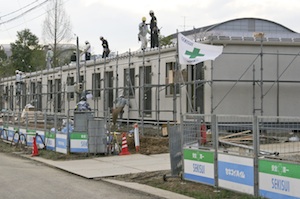A supplementary, $50 billion (¥4.015 trillion) budget passed by the Japanese Diet last week to aid regions damaged by the earthquake and tsunami of March 11, 2011, will focus resources on quickly repairing roads and port facilities, debris removal and support for disaster survivors. A second, much larger supplementary budget is expected to follow for full-scale reconstruction later this summer, according to the Tokyo-based, English language newspaper, the Daily Yomiuri.

The budget includes about $15 billion for public works projects to repair and improve roads, ports and river-related facilities; $4.4 billion for debris removal; and about $7.5 billion to support disaster survivors, such construction of temporary housing and reducing health insurance premiums. Another $65 million was appropriated to aid farmers and business owners whose operations have been halted by the disaster.
The funds to cover the first supplementary budget will come from the redirection of existing revenue. The submission of a second, larger supplementary budget of as much as $249 billion (¥20 trillion), to be funded by a government bond issue, is expected later this year.
Meanwhile, a15-member Reconstruction Design Council has been established by Prime Minister Naoto Kan to recommend measures not only for the physical reconstruction of towns and villages but also for economic revival, job re-creation and the financing of those efforts.
The panel will be led by Makoto Iokibe, a historian of politics and diplomacy who is president of the National Defense Academy. Other members include the governors of the three most affected prefectures as well as representatives of the business community. Noted Japanese architect Tadao Ando also is a member.
At an April 26 press conference in Tokyo, Iokibe, who was involved in planning the reconstruction of Kobe after the 1995 Great Hanshin Earthquake, said, “It is not enough to simply restore things to the way they were before.” He said the council is investigating innovative approaches that include relocating residential areas, schools and hospitals on naturally high ground; piling the rubble into mounds that might serve as parks until needed as tsunami refuges; and ensuring that buildings along the coast are tall and robust enough to provide shelter from tsunamis.
“We are really investigating a new approach to city planning,” Iokibe said.

Post a comment to this article
Report Abusive Comment